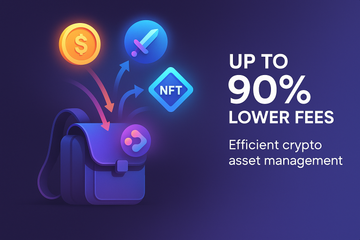Ever wondered what it would be like to keep your entire crypto collection in just one sleek container? No more juggling endless contracts or fretting over messy transfers—welcome to the world of ERC-1155. If you’ve been knee-deep in crypto collectibles or gaming tokens, you might have heard about this multi-token standard. But what’s all the fuss about?
Why Stack Up When You Can Pack Light?
Picture this: You’ve got a pile of magic swords, gold coins, and rare skins—all tucked into different drawers. Wouldn’t one all-in-one chest be just easier? That’s the concept behind ERC-1155. Instead of dealing with separate contracts for every type of digital asset, this standard lets you roll them up into a single smart contract. Fungible tokens, non-fungible creatures, and even those semi-fungible oddballs can now live happily together. There’s no need to reinvent the wheel for each new item, which feels almost too convenient, right?
In simple terms, ERC-1155 fuses the strengths of its predecessors, ERC-20 (good old fungible tokens like DAI or USDC), and ERC-721 (think CryptoKitties and other NFTs), making it a sort of Swiss Army knife for Ethereum tokens (Coinbase).
Batching: The Secret Sauce
You know what’s really neat? Batch transfers. Imagine dragging and dropping a handful of different assets to someone else—no separate transactions to clog up the Ethereum highway. With ERC-1155, you can transfer a bunch of tokens (say, three game swords, five coins, and a mysterious potion) all at once, with just one transaction fee. That’s a huge deal, especially if you’ve grimaced at gas fees lately. Some numbers float around about gas saving by up to 90% compared to the ERC-721 standard (Chetu), but honestly, after a few transfers, you don’t need convincing—your wallet feels the difference.
Safe, Not Sorry: Keeping Crypto in the Right Hands
Raise your hand if you’ve ever sent tokens to the wrong address. It’s kind of soul-crushing, isn’t it? ERC-1155 brings in some protective measures. When you move your assets, the contract checks if it’s about to land at a valid address. If things aren’t right? Boom, it cancels the transaction. Think of it as bouncing a bad check, but with way less paperwork (and way more peace of mind). It’s a little thing, but prevents a boatload of headaches.
Comparing Apples, Oranges, and… Swiss Army Knives?
Let’s break it down. ERC-20 handles things like identical poker chips—one is as good as another. ERC-721 treats each token like a snowflake, unique and one-of-a-kind. ERC-1155? It lets you manage your whole chip collection, snowflakes, and even semi-fungibles in a single box. That flexibility is a lifesaver for developers and a treat for users. Don’t get me started on batch transfers and batch approvals, either. ERC-20 and ERC-721 can’t hold a candle to these features (Binance Academy).
- ERC-20: Only fungible tokens. No batch magic.
- ERC-721: Only NFTs. Awkward for mass transfers.
- ERC-1155: Handles all of the above, and does it efficiently.
The bottom line? If you want flexibility and lower fees, ERC-1155 offers a clear win.
Getting Practical: Gaming, Collectibles, and Real-World Use
Let’s step out of theory for a bit. Where are folks actually using ERC-1155? The gaming world snapped it up quickly. Games like Gods Unchained and Enjin’s platform let players swap and trade anything from digital swords to rare potions—sometimes in one tidy bundle (Enjin). You can imagine collectors trading entire sets as a single asset, which just wasn’t practical before.
This isn’t just about fun and games. Decentralized exchanges (DEXs) and even marketplaces for tangible goods are eyeing ERC-1155 for its ability to handle mixed baskets of tokens. Imagine sending a bag of stablecoins and a few rare NFTs as payment in a single move.
What About Hardware Wallets?
Storing your collection safely is key—crypto folks love their hardware wallets. Both Trezor and Ledger are expanding support for ERC-1155 tokens, though as of mid-2024, integration can be a bit hit-or-miss depending on the ecosystem and wallet firmware updates. If you’re serious about security (and you should be!), keep an eye on wallet compatibility when working with ERC-1155 assets. Nothing’s more frustrating than a prized NFT locked in a wallet you can’t access.
Security & Transparency: Trust, But Verify
Here’s a subtle thing that gets overlooked: ERC-1155 logs almost every move you (or your contract) make. So if there’s a mint, burn, or trade, it’s tracked—no more mysteries or untraceable shenanigans. Plus, by building in features that help recover tokens from errors, the standard builds trust (and probably saves a few friendships along the way).
Is ERC-1155 the Answer for Everyone?
Alright, let’s pump the brakes for a second. ERC-1155 isn’t a magic bullet. It’s fantastic for ecosystems where you need a toolbox—like gaming or digital art. If you’re only running a simple token, you might not need all this overhead. Sometimes the good old ERC-20 or ERC-721 does the trick. But the space is moving rapidly. As more platforms add support and wallets catch up, you might just find ERC-1155 growing on you.
The Final Word (For Now)
The Ethereum ecosystem never stands still, and ERC-1155 is proof that crypto tech can be both practical and creative. By combining speed, security, and flexibility, this standard makes asset management more fun and much less stressful—kind of like having your own digital backpack that never runs out of space.
So, whether you’re a gamer, a serious collector, or just like having your options open, keep an eye on ERC-1155. It might not be perfect, but hey, who says innovation ever comes with guarantees?











